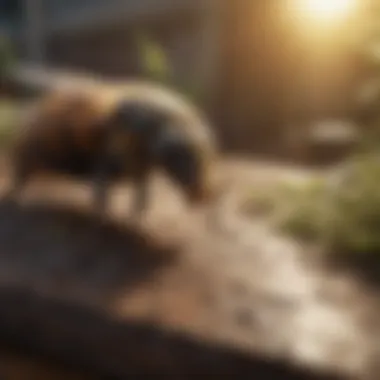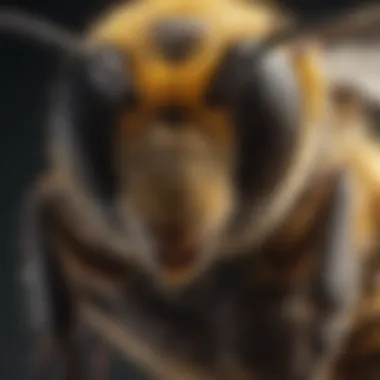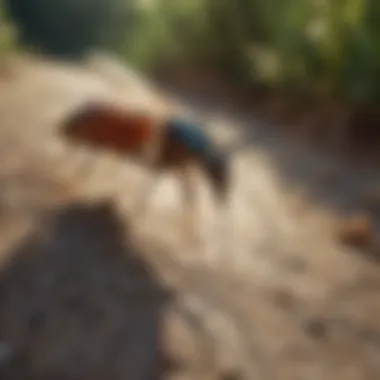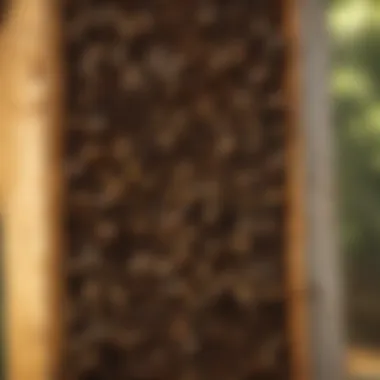Effective Strategies for Managing Bugs and Bees: A Comprehensive Guide


Preventive Pest Control Strategies
Preventive pest control strategies are essential for effectively managing common pests like bugs and bees within residential environments. It is crucial to implement a multifaceted approach to ward off potential infestations.
House Exterior Protection
When addressing preventive measures, starting with the house exterior is paramount. Tips for sealing cracks in walls and foundations can prevent easy access for pests. Clearing debris from around the house eliminates potential shelter for pests. Additionally, methods such as installing proper seals on doors and windows can deter pests from finding their way indoors.
Yard Maintenance
Maintaining a well-kept yard is instrumental in pest control. Essential yard care routines include regular mowing, trimming vegetation, and removing standing water where pests breed. By implementing pest-resistant plants and applying safe pest control products in the yard, homeowners can create an environment that discourages pests.
Indoor Cleanliness
Indoor cleanliness plays a significant role in pest prevention. Expert cleaning tips involve keeping surfaces clean, eliminating food sources, and reducing clutter where pests may hide. Maintaining a pest-resistant indoor environment entails proper storage of food, regular vacuuming, and sealing food containers tightly to avoid attracting pests.
Garbage Disposal
Proper garbage disposal methods are crucial in preventing pests from being attracted to the household. It is essential to dispose of waste efficiently and ensure bins are tightly sealed to avoid odors that can draw pests near. Educating oneself on the importance of proper garbage disposal not only maintains cleanliness but also reduces the risk of pest infestations.
Other Pest Prevention Strategies
Innovative ways to safeguard your home against pests include utilizing natural repellents, incorporating soundproofing materials, and investing in pest-resistant furniture. Understanding the behavior and preferences of common pests can aid in implementing tailored prevention strategies for long-term pest management. Engaging in practices such as regularly inspecting and maintaining structures can also contribute to a pest-free home environment.
Understanding Bugs and Bees
In the realm of pest control, understanding bugs and bees is of paramount importance. This section serves as the foundation for effective pest management strategies. By delving into the intricacies of bug and bee behavior, readers gain valuable insights into how to tackle infestations proactively. Understanding the differentiating factors between bugs and bees is crucial for identifying the right control methods for each. It also sheds light on the significance of pest control measures in preserving the environment and safeguarding human health.
Introduction to Bugs and Bees
Differentiating Between Bugs and Bees
When it comes to differentiating between bugs and bees, it is essential to consider their physical characteristics, nesting behaviors, and roles in the ecosystem. Bugs typically have piercing-sucking mouthparts, while bees have specialized mouthparts for collecting pollen and nectar. Understanding these distinctions aids in formulating targeted pest control solutions. The ability to distinguish between beneficial bees and harmful bugs is vital for maintaining ecological balance and protecting agricultural crops.
Importance of Pest Control
The importance of pest control cannot be overstated in mitigating the adverse effects of bug and bee infestations. Effective pest management not only safeguards property and crops but also enhances public health. Implementing proper pest control measures reduces the risk of diseases transmitted by insects such as mosquitoes and ticks. Furthermore, it contributes to sustainable agriculture by promoting natural pollination processes and ecosystem equilibrium.


Behavioral Patterns
Foraging Habits of Bees
Understanding the foraging habits of bees is key to appreciating their vital role in pollination. Bees exhibit intricate behaviors when searching for pollen and nectar, contributing to the reproduction of flowering plants. Their ability to navigate vast distances in search of floral resources showcases the efficiency of their foraging tendencies. By comprehending these habits, individuals can foster bee-friendly environments and support ecosystem biodiversity.
Nesting Behaviors of Bugs
Exploring the nesting behaviors of bugs unveils the diversity of habitats these organisms seek for shelter and reproduction. Bugs may utilize various materials and surroundings to build their nests, ranging from decaying wood to soil crevices. Studying these nesting patterns aids in disrupting bug colonies and preventing infestations. Awareness of bug nesting behaviors empowers homeowners to proactively address potential pest entry points and protect their living spaces.
Life Cycles
Reproduction Processes
The reproduction processes of bugs and bees are intricate phenomena that play a significant role in pest population dynamics. Understanding the reproductive strategies of pests enables targeted control measures to disrupt their life cycles effectively. By grasping the nuances of bee mating rituals and bug reproduction mechanisms, individuals can thwart pest proliferation and minimize environmental impact.
Development Stages
Exploring the development stages of bugs and bees sheds light on their metamorphosis processes and growth trajectories. From egg to larva to adult, each stage in the life cycle of insects presents distinct vulnerabilities for pest management interventions. Monitoring the development stages of bugs and bees facilitates timely intervention strategies and ensures comprehensive pest control outcomes.
Pest Identification
When delving into the realm of pest control, understanding the significance of pest identification is paramount for effective management strategies. Pest identification serves as the foundational step in devising targeted approaches to tackle pest issues. By correctly identifying the specific pests at hand, individuals can tailor their interventions to address the unique characteristics and behaviors of bugs and bees.
Recognizing Common Bugs and Bees
Key Characteristics of Bugs
Exploring the key characteristics of bugs is crucial in aiding pest identification efforts. By discerning these unique traits, such as body shape, color patterns, and movement behavior, individuals can accurately distinguish between various bug species. Moreover, understanding the key characteristics of bugs allows for the identification of potential risks associated with certain species, aiding in the development of strategic pest control measures.
In this comprehensive guide on pest control, highlighting the key characteristics of bugs assists readers in recognizing common bug species prevalent in their surroundings. By shedding light on these distinguishing features, individuals can proactively mitigate bug infestations and safeguard their living spaces effectively.
Distinct Features of Bees
Exploring the distinct features of bees contributes significantly to pest identification endeavors. Bees exhibit unique characteristics such as body structure, wing morphology, and behavior patterns that differentiate them from other insect species. Recognizing these distinct features enables individuals to differentiate between various bee species and understand their roles within ecosystems.
In this article, emphasizing the distinct features of bees aims to enhance readers' awareness of different bee varieties and their behaviors. By outlining these features, individuals can better comprehend bee infestations, nesting preferences, and potential hazards associated with bee presence, facilitating informed pest control decisions.
Signs of Infestation


Damage Patterns
Understanding the damage patterns caused by bugs and bees is instrumental in detecting infestations early and implementing appropriate pest control measures. Different pests exhibit characteristic signs of damage, including leaf degradation, tunneling marks, or honeycomb structures, which serve as indicators of their presence.
In this detailed guide on pest control, elucidating the damage patterns caused by bugs and bees equips readers with the knowledge to identify and respond to infestations promptly. By familiarizing individuals with these distinctive damage signs, the article empowers readers to take proactive steps in safeguarding their properties and environments from pest-related harm.
Swarms and Nests
Exploring the behaviors of bugs and bees concerning swarms and nests provides valuable insights into potential infestation risks. Swarming behavior, characteristic of some bee species, signals the establishment of new colonies, while nests constructed by bugs denote breeding sites and potential habitats within residential or outdoor spaces.
In this comprehensive discussion on pest control, focusing on swarms and nests enhances readers' understanding of infestation indicators associated with bees and bugs. By highlighting these distinctive behaviors, individuals can recognize swarm formations and nest locations, enabling them to enlist targeted pest management strategies effectively.
Preventive Measures
Preventive measures play a crucial role in mitigating bug and bee infestations, making it a pivotal aspect of this comprehensive guide on pest control. By focusing on proactive strategies, individuals can prevent the onset of pest problems before they escalate, thus minimizing potential damage and inconveniences. The significance of preventive measures lies in their ability to create a hostile environment for pests, deterring their presence and safeguarding properties effectively.
Natural Repellents
Essential Oils:
In the realm of natural pest control, essential oils stand out as a powerful asset due to their potent insect-repelling properties. Essential oils, derived from plants, offer a natural and non-toxic solution for deterring bugs and bees. One key characteristic of essential oils is their versatility in targeting a wide range of pests while emitting pleasant fragrances for humans. The unique feature of essential oils lies in their eco-friendly nature, making them a preferred choice for environmentally conscious individuals looking to combat pests effectively.
Herbal Remedies:
Herbal remedies provide an alternative approach to pest control by harnessing the power of nature's ingredients. These remedies, typically concocted from a blend of herbs and botanicals, serve as a safe and sustainable solution for managing pest issues. The key characteristic of herbal remedies is their gentle yet effective repellent qualities, making them a popular choice for households seeking natural pest control methods. The unique feature of herbal remedies lies in their ability to target pests without harmful chemicals, offering a more holistic approach to pest management.
Physical Barriers
Mesh Screens:
When it comes to physical barriers, mesh screens emerge as a crucial line of defense against bugs and bees. Mesh screens act as a protective shield, preventing pests from infiltrating living spaces while promoting ventilation and natural light. The key characteristic of mesh screens is their durability and adaptability to different window and door sizes, making them a versatile option for pest prevention. The unique feature of mesh screens lies in their ability to provide a clear view of the outdoors while effectively blocking pests, striking a balance between functionality and aesthetics.
Sealing Cracks:
Sealing cracks serves as a fundamental preventive measure in pest control, particularly in keeping out insects and rodents from indoor spaces. By identifying and sealing cracks in walls, floors, and foundations, individuals can block potential entry points for pests, thereby fortifying the structural integrity of their homes. The key characteristic of sealing cracks is its role in enhancing insulation and energy efficiency, besides acting as a barrier against pests. The unique feature of sealing cracks lies in its cost-effective nature and long-term benefits, making it an essential component of pest prevention strategies.
Environmental Controls


Moisture Regulation:
Effective moisture regulation is instrumental in pest control efforts, as excess moisture can attract and sustain a conducive environment for bugs and bees. Managing moisture levels through proper ventilation, dehumidification, and drainage systems helps in deterring pests that thrive in damp conditions. The key characteristic of moisture regulation is its ability to prevent mold growth and decay, limiting the attraction of various pests to properties. The unique feature of moisture regulation lies in its dual benefit of safeguarding against pests and preserving the structural integrity of buildings, highlighting its essential role in comprehensive pest control strategies.
Light Management:
Light management plays a subtle yet significant role in pest prevention by influencing insect behavior and movement patterns. By strategically adjusting lighting levels indoors and outdoors, individuals can deter nocturnal pests such as moths and beetles. The key characteristic of light management is its ability to disrupt the navigation and foraging habits of certain pests, steering them away from inhabited areas. The unique feature of light management lies in its non-intrusive method of pest control, offering a passive yet effective approach to minimizing pest presence in residential and commercial settings.
Professional Interventions
Professional interventions play a crucial role in the realm of bugs and bees pest control, offering specialized expertise and resources to effectively manage infestations. In this comprehensive guide, focusing on professional interventions brings forth specific elements that cater to the unique challenges posed by pests like bugs and bees. By leveraging the skills and knowledge of pest control professionals, individuals can address pest issues efficiently and proactively.
Integrated Pest Management
Chemical Treatments
Chemical treatments form a vital component of integrated pest management strategies, contributing significantly to the overall goal of pest control. These treatments involve the strategic use of insecticides or pesticides to target pests like bugs and bees, disrupting their life cycles and minimizing infestations. The key characteristic of chemical treatments lies in their ability to offer quick and targeted solutions, making them a popular choice for addressing pest issues promptly.
One of the unique features of chemical treatments is their ability to provide immediate results, rapidly reducing pest populations within the affected area. However, it is essential to consider the potential disadvantages of chemical treatments, such as environmental impact and potential harm to non-target species.
Biological Controls
In contrast, biological controls offer a more eco-friendly approach to integrated pest management, utilizing natural predators or parasites to regulate pest populations effectively. By introducing predator species or pathogens that specifically target pests like bugs or bees, biological controls help maintain ecological balance while combating infestations. The key characteristic of biological controls lies in their sustainability and minimal impact on the environment, making them a beneficial choice for environmentally conscious pest control approaches.
A unique feature of biological controls is their long-term effectiveness, as predator populations establish a natural equilibrium that can keep pest populations in check over time. However, it is essential to consider the potential disadvantages, such as the time needed for these controls to show significant results and the variability in effectiveness depending on environmental conditions.
Consulting Pest Control Services
Assessment and Planning
Effective pest control services begin with thorough assessment and meticulous planning to tailor strategies to the specific pest challenges being faced. Assessment involves identifying the type and extent of infestations, evaluating environmental factors, and determining the most suitable approach for pest management. This initial phase is crucial in developing a targeted and effective pest control plan that addresses the root cause of pest problems.
The key characteristic of assessment and planning is its`
| Continued in next section for Implementation Strategies |
Conclusion
In the realm of exploring bugs and bees pest control, the conclusion plays a pivotal role in summarizing the essential takeaways and reinforcing the significance of proactive pest management strategies. As readers embark on this comprehensive guide, it becomes evident that a well-rounded understanding of bugs and bees' behaviors, lifecycles, and preventive measures is crucial for effectively addressing pest issues.
The conclusion of this article serves as a consolidation of knowledge acquired throughout the different sections, synthesizing key information on bug and bee pest control into actionable insights. By emphasizing the importance of implementing preventive measures and recognizing early signs of infestations, readers are empowered to tackle pest issues before they escalate into significant problems.
Moreover, the conclusion serves as a reminder of the environmental impact of bugs and bees infestations, highlighting the need for sustainable pest control practices that minimize harm to beneficial insects and ecosystems. This resonates with the growing awareness of eco-friendly pest management solutions that prioritize natural repellents and physical barriers over harsh chemicals.
Moving forward, the conclusion prompts readers to adopt an integrated approach towards pest control, combining natural remedies, physical interventions, and professional services to create a comprehensive defense mechanism against bugs and bees. By underlining the long-term benefits of investing time and effort in pest prevention, the conclusion encourages readers to take a proactive stance towards maintaining a pest-free environment.



